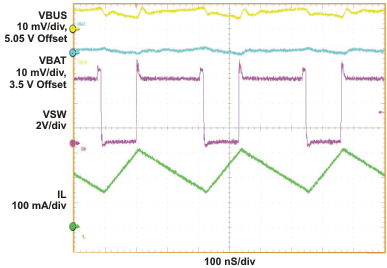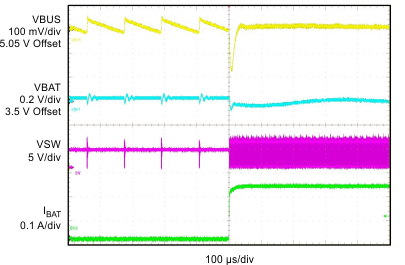SLUSAB0D October 2010 – April 2016
UNLESS OTHERWISE NOTED, this document contains PRODUCTION DATA.
- 1 Features
- 2 Applications
- 3 Description
- 4 Revision History
- 5 Description (Continued)
- 6 Device Comparisons
- 7 Pin Configuration and Functions
- 8 Specifications
-
9 Detailed Description
- 9.1 Overview
- 9.2 Functional Block Diagram
- 9.3 Feature Description
- 9.4
Device Functional Modes
- 9.4.1 Charge Mode Operation
- 9.4.2 PWM Controller in Charge Mode
- 9.4.3 Battery Charging Process
- 9.4.4 Thermal Regulation and Protection
- 9.4.5 Charge Status Output, STAT Pin
- 9.4.6 Control Bits in Charge Mode
- 9.4.7 Control Pins in Charge Mode
- 9.4.8 BOOST Mode Operation (bq24153A/8 only)
- 9.4.9 High Impedance (HI-Z) Mode
- 9.5 Programming
- 9.6
Register Maps
- 9.6.1 Status/Control Register [Memory Location: 00, Reset State: x1xx 0xxx]
- 9.6.2 Control Register [Memory Location: 01, Reset State: 0011 0000]
- 9.6.3 Control/Battery Voltage Register [Memory Location: 02, Reset State: 0000 1010]
- 9.6.4 Vender/Part/Revision Register [Memory Location: 03, Reset State: 0101 000x]
- 9.6.5 Battery Termination/Fast Charge Current Register [Memory Location: 04, Reset State: 0000 000]
- 9.6.6 Special Charger Voltage/Enable Pin Status Register [Memory location: 05, Reset state: 001X X100]
- 9.6.7 Safety Limit Register [Memory location: 06, Reset state: 01000000]
- 10Application and Implementation
- 11Power Supply Recommendations
- 12Layout
- 13Device and Documentation Support
- 14Mechanical, Packaging, and Orderable Information
Package Options
Mechanical Data (Package|Pins)
- YFF|20
Thermal pad, mechanical data (Package|Pins)
Orderable Information
10 Application and Implementation
NOTE
Information in the following applications sections is not part of the TI component specification, and TI does not warrant its accuracy or completeness. TI’s customers are responsible for determining suitability of components for their purposes. Customers should validate and test their design implementation to confirm system functionality.
10.1 Application Information
The bq24153A/6A/8/9 is a compact, flexible, high-efficiency, USB-friendly, switch-mode charge management solution for single-cell Li-ion and Li-polymer batteries used in a wide range of portable applications. The devices integrate a synchronous PWM controller, power MOSFETs, input current sensing, high-accuracy current and voltage regulation, and charge termination, into a small DSBGA package. The charge parameters can be programmed through an I2C interface.
10.2 Typical Application
VBUS = 5 V, ICHARGE = 1250 mA, VBAT = 3.5 V to 4.44 V (Adjustable).
10.2.1 Design Requirements
Use the following typical application design procedure to select external components values for the bq24153A/6A/8/9 device.
Table 10. Design Parameters
| SPECIFICATIONS | TEST CONDITIONS | MIN | TYP | MAX | UNIT |
|---|---|---|---|---|---|
| Input DC voltage, VIN | Input voltage from AC adapter input | 4 | 5 | 6 | V |
| Input current | Maximum input current from AC adapter input | 0.1 | 0.1 to 0.5 | 1.5 | A |
| Charge current | Battery charge current | 0.325 | 0.7 | 1.55 | A |
| Output regulation voltage | Voltage applied to VBAT | 0 | 0.3 to 4.2 | 4.44 | V |
| Operating junction temperature range, TJ | 0 | 125 | °C | ||
10.2.2 Detailed Design Procedure
10.2.2.1 Systems Design Specifications
- VBUS = 5 V
- VBAT = 4.2 V (1-Cell)
- I(charge) = 1.25 A
- Inductor ripple current = 30% of fast charge current
- Determine the inductor value (LOUT) for the specified charge current ripple:
- Determine the output capacitor value (COUT) using 40 kHz as the resonant frequency:
- Determine the sense resistor using the following equation:
- Measured efficiency and total power loss with different inductors are shown in Figure 26 and Figure 27. SW node and inductor current waveform are shown in Figure 2.
 , the worst case is when battery voltage is as close as to half of the input voltage.
, the worst case is when battery voltage is as close as to half of the input voltage.

LOUT = 1.11 μH
Select the output inductor to standard 1 μH. Calculate the total ripple current with using the 1-μH inductor:


ΔIL = 0.42 A
Calculate the maximum output current:


ILPK = 1.46 A
Select 2.5mm by 2mm 1-μH 1.5-A surface mount multi-layer inductor. The suggested inductor part numbers are shown as following.
Table 11. Inductor Part Numbers(1)
| PART NUMBER | INDUCTANCE | SIZE | MANUFACTURER |
|---|---|---|---|
| LQM2HPN1R0MJ0 | 1 μH | 2.5 x 2.0 mm | Murata |
| MIPS2520D1R0 | 1 μH | 2.5 x 2.0 mm | FDK |
| MDT2520-CN1R0M | 1 μH | 2.5 x 2.0 mm | TOKO |
| CP1008 | 1 μH | 2.5 x 2.0 mm | Inter-Technical |



COUT = 15.8 μF
Select two 0603 X5R 6.3V 10-μF ceramic capacitors in parallel i.e., Murata GRM188R60J106M.

The maximum sense voltage across the sense resistor is 85 mV. In order to get a better current regulation accuracy, V(RSNS) should equal 85mV, and calculate the value for the sense resistor.

R(SNS) = 68 mΩ
This is a standard value. If it is not a standard value, then choose the next close value and calculate the real charge current. Calculate the power dissipation on the sense resistor:
P(RSNS) = I(CHARGE) 2 × R(SNS)
P(RSNS) = 1.252 × 0.068
P(RSNS) = 0.106 W
Select 0402 0.125-W 68-mΩ 2% sense resistor, i.e. Panasonic ERJ2BWGR068.

| TA = 25°C | VBUS = 5 V | VBAT = 3 V |

| TA = 25°C | VBUS = 5 V | VBAT = 3 V |
10.2.2.2 Charge Current Sensing Resistor Selection Guidelines
Both the termination current range and charge current range depend on the sensing resistor (RSNS). The termination current step (IOTERM_STEP) can be calculated using Equation 11:

Table 12 shows the termination current settings for three sensing resistors.
Table 12. Termination Current Settings for 55-mΩ, 68-mΩ, 100-mΩ Sense Resistors
| BIT | VI(TERM) (mV) | I(TERM) (mA) R(SNS) = 55mΩ |
I(TERM) (mA) R(SNS) = 68mΩ |
I(TERM) (mA) R(SNS) = 100mΩ |
|---|---|---|---|---|
| VI(TERM2) | 13.6 | 247 | 200 | 136 |
| VI(TERM1) | 6.8 | 124 | 100 | 68 |
| VI(TERM0) | 3.4 | 62 | 50 | 34 |
| Offset | 3.4 | 62 | 50 | 34 |
For example, with a 68-mΩ sense resistor, V(ITERM2)=1, V(ITERM1)=0, and V(ITERM0)=1, ITERM = [ (13.6mV x 1) + (6.8mV x 0) + (3.4mV x 1) + 3.4mV ] / 68mΩ = 200mA + 0 + 50mA + 50mA = 300mA.
The charge current step (IO(CHARGE_STEP)) is calculated using Equation 12:

Table 13 shows the charge current settings for three sensing resistors.
Table 13. Charge Current Settings for 55-mΩ, 68-mΩ and 100-mΩ Sense Resistors
| BIT | VI(REG) (mV) | IO(CHARGE) (mA) R(SNS) = 55mΩ |
IO(CHARGE) (mA) R(SNS) = 68mΩ |
IO(CHARGE) (mA) R(SNS) = 100mΩ |
||||
|---|---|---|---|---|---|---|---|---|
| bq24156A bq24159 |
bq24153A bq24158 |
bq24156A bq24159 |
bq24153A bq24158 |
bq24156A bq24159 |
bq24153A bq24158 |
bq24156A bq24159 |
bq24153A bq24158 |
|
| VI(CHRG3) | 54.4 | 27.2 | 989 | 495 | 800 | 400 | 544 | 272 |
| VI(CHRG2) | 27.2 | 13.6 | 495 | 247 | 400 | 200 | 272 | 136 |
| VI(CHRG1) | 13.6 | 6.8 | 247 | 124 | 200 | 100 | 136 | 68 |
| VI(CHRG0) | 6.8 | n/a | 124 | n/a | 100 | n/a | 68 | n/a |
| Offset | 37.4 | 37.4 | 680 | 680 | 550 | 550 | 374 | 374 |
Using bq24156A as an example, with a 68-mΩ sense resistor, V(CHRG3)=1, V(CHRG2)=0, V(ICHRG1)=0, and V(ICHRG0)=1, ITERM = [ (54.4mV x 1) + (27.2mV x 0) + (13.6mV x 0) + (6.8mV x 1) + 37.4mV ] / 68mΩ = 800mA + 0 + 0 + 100mA = 900mA.
10.2.2.3 Output Inductor and Capacitance Selection Guidelines
The IC provides internal loop compensation. With the internal loop compensation, the highest stability occurs when the LC resonant frequency, fo, is approximately 40 kHz (20 kHz to 80 kHz). Equation 13 can be used to calculate the value of the output inductor, LOUT, and output capacitor, COUT.

To reduce the output voltage ripple, a ceramic capacitor with the capacitance between 4.7 μF and 47 μF is recommended for COUT, see the application section for components selection.
10.2.3 Application Curves
Using circuit shown in Figure 25, TA = 25°C, unless otherwise specified.

| VBUS = 0-5V, | Iin_limit = 500mA, | Voreg = 4.2V |
| VBAT = 3.5V, | ICHG = 550mA, | 32S mode |

| VBUS = 5V, | No Battery Connected | |

| VBUS = 5.05 V, | VBAT = 3.5V, | IBUS = 217 mA |

| VBUS = 5.05 V, | VBAT = 3.5V, | IBUS = 0-217 mA |

| VBUS = 5 V, | VBAT = 3.4V, | Iin_limit = 500 mA |
| (32s Mode) |

| VBUS = 5V, | No Battery Connected | |

| VBUS = 5.05 V, | VBAT = 3.5V, | IBUS = 42 mA |

| VBUS = 5.05 V, | VBAT = 3.5V, | IBUS = 217 mA |
10.3 System Example
VBUS = 5 V, ICHARGE = 1550 mA, Vbat = 3.5 V to 4.44 V (adjustable).
 Figure 36. I2C Controlled 1-Cell Charger Application Circuit with External Safety Limit Register Control
Figure 36. I2C Controlled 1-Cell Charger Application Circuit with External Safety Limit Register Control
